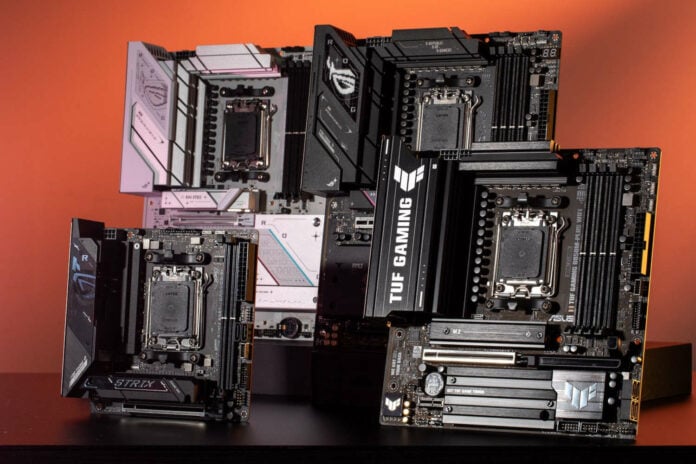In 2025, both AMD and Intel introduced their respective B850 and B860 chipsets. Each make purchasing a Socket AM5 or LGA1851 motherboard easier through greater affordability. However, it can be difficult to understand the exact differences between these new standards and their counterparts, namely X870(E) and Z890. In a bid to clear things up, I’ll be offering an explanation on each chipset while highlighting some of Asus’ models as a demonstration of their capabilities in action.
Before we dive in to chipsets and motherboards, here’s a note on CPU compatibility. B850 motherboards support all AMD Ryzen 7000, 8000, and 9000 processors out of the box. The only exceptions to this rule are Ryzen 9 9950X3D and 9900X3D, which require BIOS updates prior to installation. Meanwhile, B860 motherboards will work with all Intel Core Ultra 200S models, no patches needed.
AMD B850
Like B650 before it, AMD B850 offers most AM5 features at a more affordable price point. In this case, it’s actually very comparable to X870 save a few cutbacks to some enthusiast-class specifications.
For instance, PCIe 5.0 storage and USB 4 don’t come as standard with B850 but you’ll still find them on some motherboards. The only other major difference between the chipset and X870 is the number of PCIe 5.0 lanes it supports. Despite their smaller bandwidth overall, boards will still offer at least one PCIe 5.0 slot for your graphics card.
Importantly, B850 retains support for both memory and processor overclocking. Enabling the EXPO profiles on your RAM can dramatically boost system performance, which perhaps explains why AMD even makes a point to include it on cheaper B840 boards. While tinkering with CPUs isn’t as straightforward, budget builders can still try their hand at pushing their Ryzen 7000/9000X SKU chips further.
If you can forgo what are effectively enthusiast niceties, then a B850 motherboard provides all a mainstream system should need and then some. With this in mind, let’s take a look at Asus’ top-of-the-line models from each of its families.
ROG Strix
Those in search of a flashy and feature-rich B850 motherboard with a focus on performance should look to Asus ROG Strix models. These boards typically command a small premium but they’re among the best examples of AMD’s chipset you’ll find on the market.
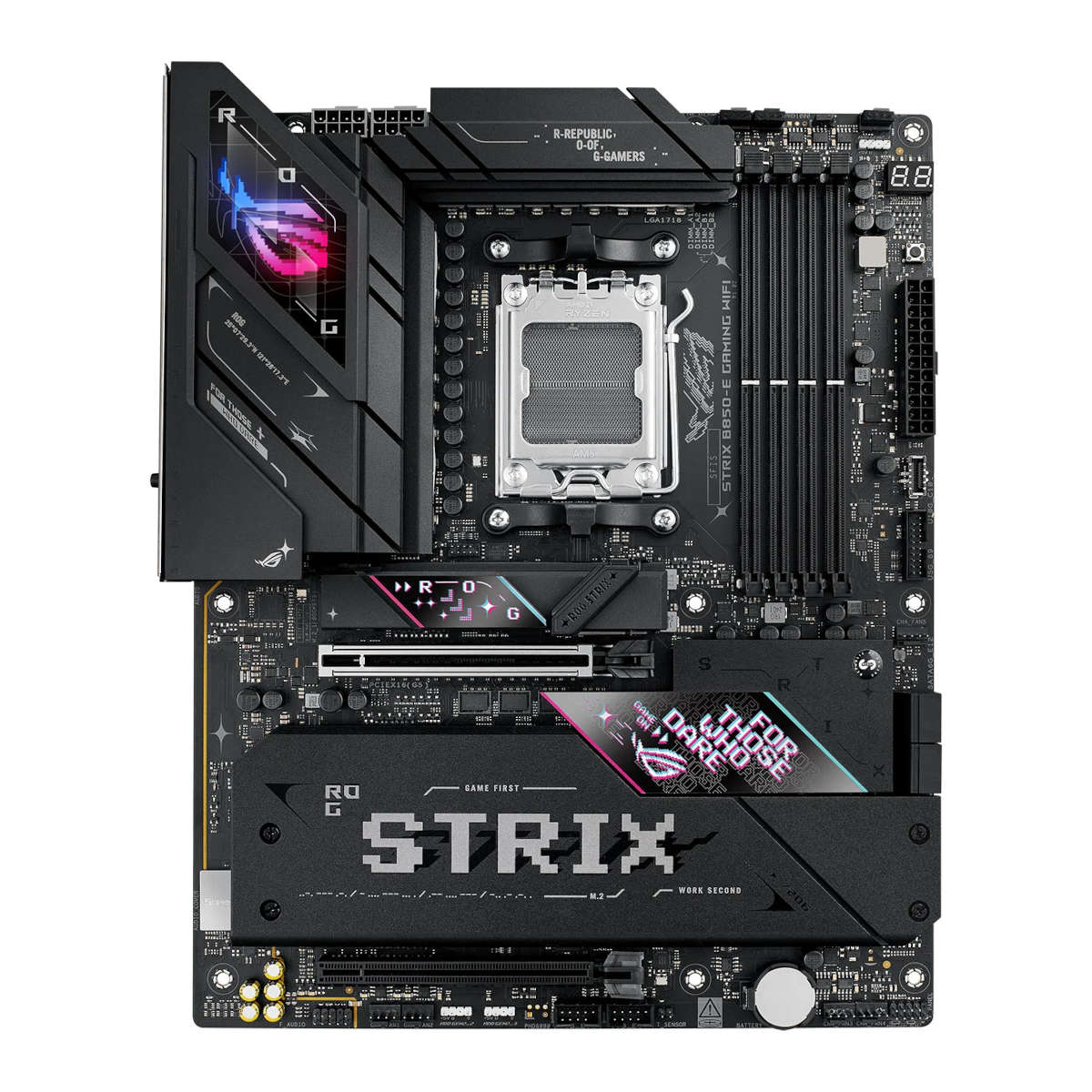
ROG Strix B850-E Gaming WiFi
“ROG Strix B850-E Gaming WiFi is engineered to harness the full potential of AMD Ryzen 9000 Series processors.” – Asus
ROG Strix B850-E Gaming WiFi sits at the head of its family of four boards, including three ATX (B850-A, B850-E, and B850-F) models and a single Mini-ITX (B850-I).
| ROG Strix B850-E Gaming WiFi | |
|---|---|
| VRM | 16+2+2, 90A |
| RAM support | Slots: 4 Capacity: 256GB Speed: 8,000+MT/s |
| Onboard graphics | DisplayPort 1.4 (x1) HDMI 2.1 (x1) USB 4 (x1) |
| PCIe expansion slots | PCIe 5.0 x16 (x1) PCIe 4.0 x16 (x1) |
| Audio | Realtek ALC4080 |
| Storage | PCIe 5.0 x4 (x3) PCIe 4.0 x4 (x2) SATA 6Gb/s (x4) |
| Rear USB | 40Gb/s Type-C (x1) 20Gb/s Type-C (x1) 10Gb/s Type-A (x6) 480Mb/s Type-A (x4) |
| Front USB | 10Gb/s Type-C (x1) 5Gb/s Type-A (x2) 480Mb/s Type-A (x4) |
| LAN | Realtek 5Gb/s |
| Wireless | Bluetooth 5.4 WiFi 7 |
Asus gives you plenty of premium fancies to delight over here. Key among them is its single USB 4 port, providing 40Gb/s of bandwidth in addition to another output for integrated graphics via its support for DP Alt Mode.
Going all-in on PCIe 5.0, a whopping three M.2 slots rock the latest standard in addition to another two PCIe 4.0 x4 ports. This hasn’t come at the expense of expansion, as Asus fits the board with a single PCIe 5.0 x16 slot alongside a PCIe 4.0 x16 header (capable of running up to x4 speeds).
Combining these eye-catching specifications with a welcomely robust 16+2+2 phase design, ample room for speedy and spacious memory, ROG Strix B850-E Gaming WiFi has all you could want from a Socket AM5 motherboard and then some. That’s not forgetting its premium Realtek ALC4080 audio codec, 5Gb/s Ethernet, and support for the latest Bluetooth and WiFi standards to boot.
Check out my Asus ROG Strix B850-I Gaming WiFi review for a detailed look at a motherboard from this family.
TUF Gaming
Striking a stronger balance between performance and price, TUF Gaming boards forgo fanciful features in favour of affordability. To do so, Asus makes smart cuts to the likes of quick-release mechanisms, RGB, and USB 4 rather than specifications core to any worthwhile mainstream motherboard.
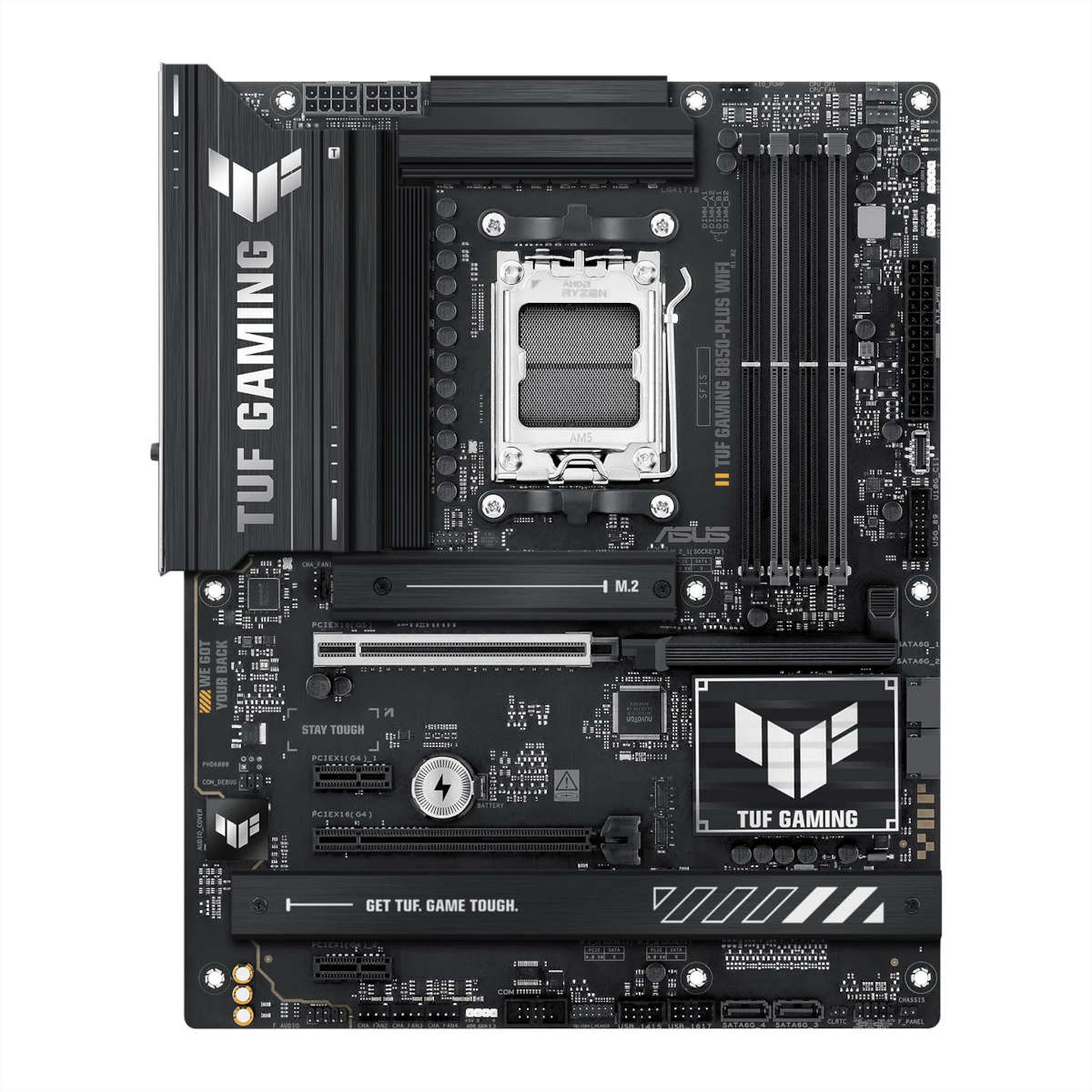
TUF Gaming B850-Plus WiFi
“TUF Gaming B850-Plus WiFi takes all the essential elements of the latest AMD Ryzen processors and combines them with game-ready features and proven durability.” – Asus
TUF Gaming B850-Plus WiFi leads its respective pack of five boards, including two ATX (B850-Plus WiFi, and B850-Plus) models, two mATX (B850M-Plus WiFi and B850M-Plus) versions, in addition to a back-connector board (B850-BTF WiFi W).
| TUF Gaming B850-Plus WiFi | |
|---|---|
| VRM | 14+2+1, 80A |
| RAM support | Slots: 4 Capacity: 256GB Speed: 8,000+MT/s |
| Onboard graphics | DisplayPort 1.4 (x1) HDMI 2.1 (x1) |
| PCIe expansion slots | PCIe 5.0 x16 (x1) PCIe 4.0 x16 (x1) PCIe 4.0 x1 (x2) |
| Audio | Realtek ALC1220P |
| Storage | PCIe 5.0 x4 (x1) PCIe 4.0 x4 (x2) SATA 6Gb/s (x4) |
| Rear USB | 20Gb/s Type-C (x1) 10Gb/s Type-A (x3) 5Gb/s Type-A (x4) 480Mb/s Type-A (x2) |
| Front USB | 10Gb/s Type-C (x1) 5Gb/s Type-A (x2) 480Mb/s Type-A (x4) |
| LAN | Realtek 2.5Gb/s |
| Wireless | Bluetooth 5.4 WiFi 7 |
As expected, the midranger ditches USB 4 but still maintains a well-rounded set of USB headers. With nine ports in total spread across its rear I/O, seven of which run at base USB 3 speeds (5Gb/s) or higher, there’s plenty of connectivity to play with here for peripherals and other devices.
Despite its chipset not mandating PCIe 5.0 storage, Asus still offers a single slot that accommodates the speediest of SSDs in addition to two PCIe 4.0 x4, all covered with heatsinks. Likewise, its PCIe 5.0 x16 expansion slot stands ready-and-waiting for the most-demanding current generation graphics cards from Nvidia GeForce RTX 5090 downwards.
VRMs understandably aren’t as robust as those you’ll find on ROG Strix models, but your processor nonetheless remains in safe hands with TUF Gaming B850-Plus WiFi’s 14+2+1 phase design. Asus also trims back Ethernet speeds to 2.5Gb/s and opts for the less-expensive Realtek ALC1200P audio codec on the board, but both are more than up to meeting the needs of most users. As a cheerful bonus, support for Bluetooth 5.4 and WiFi 7 remains intact.
Intel B860
While Z890 remains Intel’s flagship chipset, the company introduced its more affordable B860 spec. It retains much of what makes Team Blue’s LGA1851 platform enticing but there some notable differences.
Support for CPU overclocking, both IA (CPU core) and BCLK (base clock), is absent on B860. As such, it only makes sense to pair motherboards using this chipset with non-K SKU processors, such as Core Ultra 9 285(F) instead of Core Ultra 9 285K(F). However, you can still enjoy the benefits of XMP (Extreme Memory Profile) or manually tweak your RAM as you see fit.
Intel mandates PCIe 5.0 interfaces for graphics and storage on all B860 boards. With these requirements in place, the only way to make the chipset more affordable relative to Z890 is through a reduction in total bandwidth across expansion slots and USB. This means there’s no guarantee of Thunderbolt 4, but there’s still plenty of throughput to go around even after such a trim.
These are understandable trade-offs in favour of lower prices, naturally making B860 motherboards an enticing purchase for value-oriented builders. Zooming in on Asus’ offerings, let’s unpack what exactly you can expect from models currently on the market.
ROG Strix
Putting performance above all, ROG Strix B860 motherboards extract the maximum potential out of Intel’s chipset. They occupy the upper-end of the price spectrum owing to their heightened specifications but this is typical of all high-end boards.
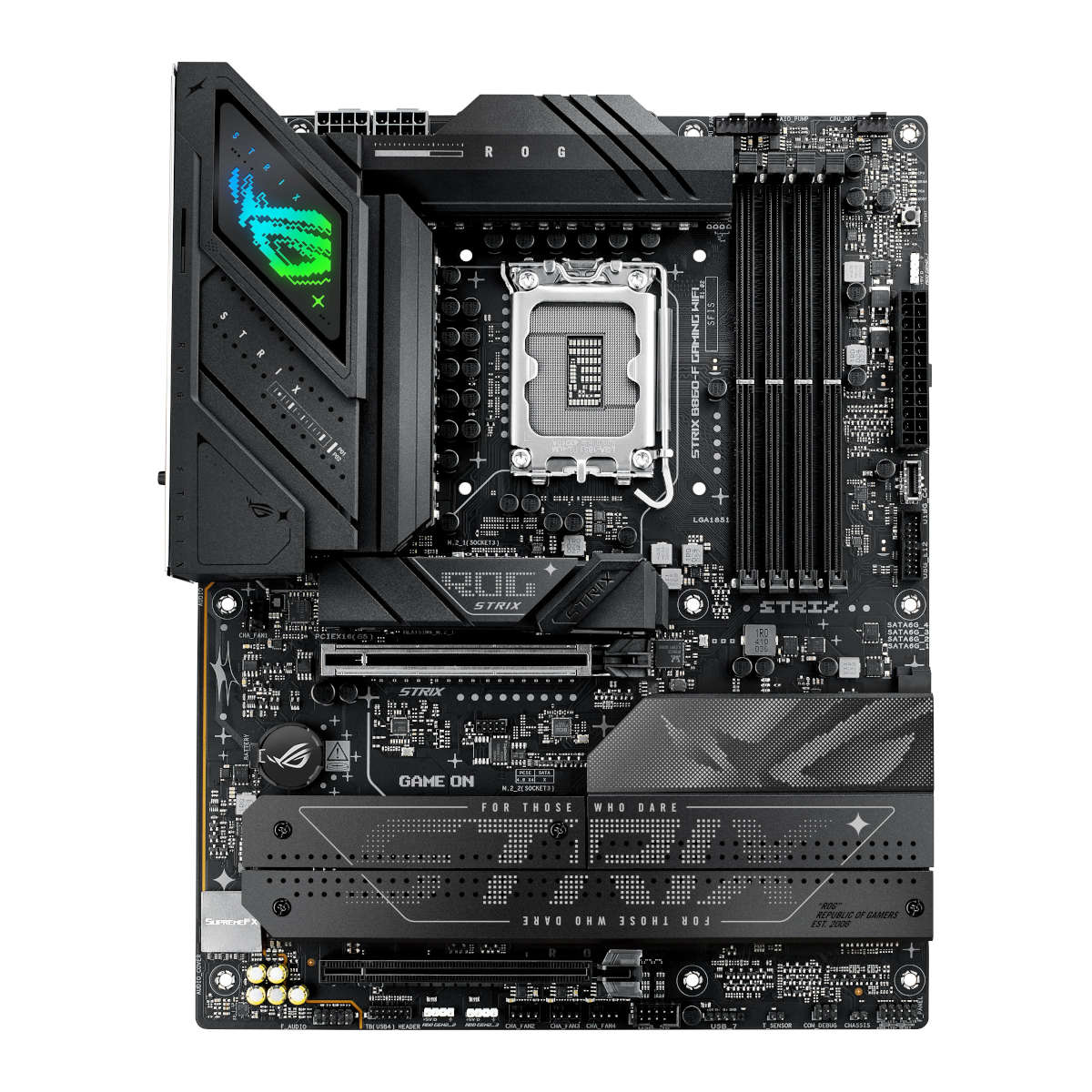
ROG Strix B860-F Gaming WiFi
“With NPU boosting and cutting-edge AI solutions, ROG Strix B860-F Gaming WiFi supports advanced AI PC applications.” – Asus
Top of the family pyramid you’ll find ROG Strix B860-F Gaming WiFi, supported by two ATX boards (B860-A, B860-G) and a single Mini ITX (B860-I).
| ROG Strix B860-F Gaming WiFi | |
|---|---|
| VRM | 16+1+2+1, 80A |
| RAM support | Slots: 4 Capacity: 256GB Speeds: 9,066+MT/s |
| Onboard graphics | DisplayPort 1.4 (x1) HDMI 2.1 (x1) Thunderbolt 4 (x1) |
| PCIe expansion slots | PCIe 5.0 x16 (x1) PCIe 4.0 x16 (x1) |
| Audio | Realtek ALC4080 |
| Storage | PCIe 5.0 x4 (x1) PCIe 4.0 x4 (x3) SATA 6Gb/s (x4) |
| Rear USB | 40Gb/s Type-C (x1) 20Gb/s Type-C (x1) 10Gb/s Type-A (x1) 5Gb/s Type-A (x6) |
| Front USB | 10Gb/s Type-C (x1) 5Gb/s Type-A (x2) 480Mb/s Type-A (x3) |
| LAN | Intel 2.5Gb/s |
| Wireless | Bluetooth 5.4 WiFi 7 |
Given the specifications above, ROG Strix B860-F Gaming WiFi comes close to giving some Z890 motherboards a run for their money. Thunderbolt 4 is duly present, alongside ample expansion through PCIe 5.0 and 4.0 interfaces for both add-in cards and storage.
There’s little doubt that it’s an exceptional B860 motherboard, if you don’t mind stretching to its higher price tag. For a detailed look at the board, check out my Asus ROG Strix B860-F Gaming WiFi review.
TUF Gaming
TUF Gaming boards have long-provided a means to enjoy Asus’ renowned build quality at a more affordable price point, in return for cuts to nice-to-haves. While the likes of Thunderbolt 4 and RGB get the chop on the series, it still offers rock-solid motherboards packing plenty of punch.
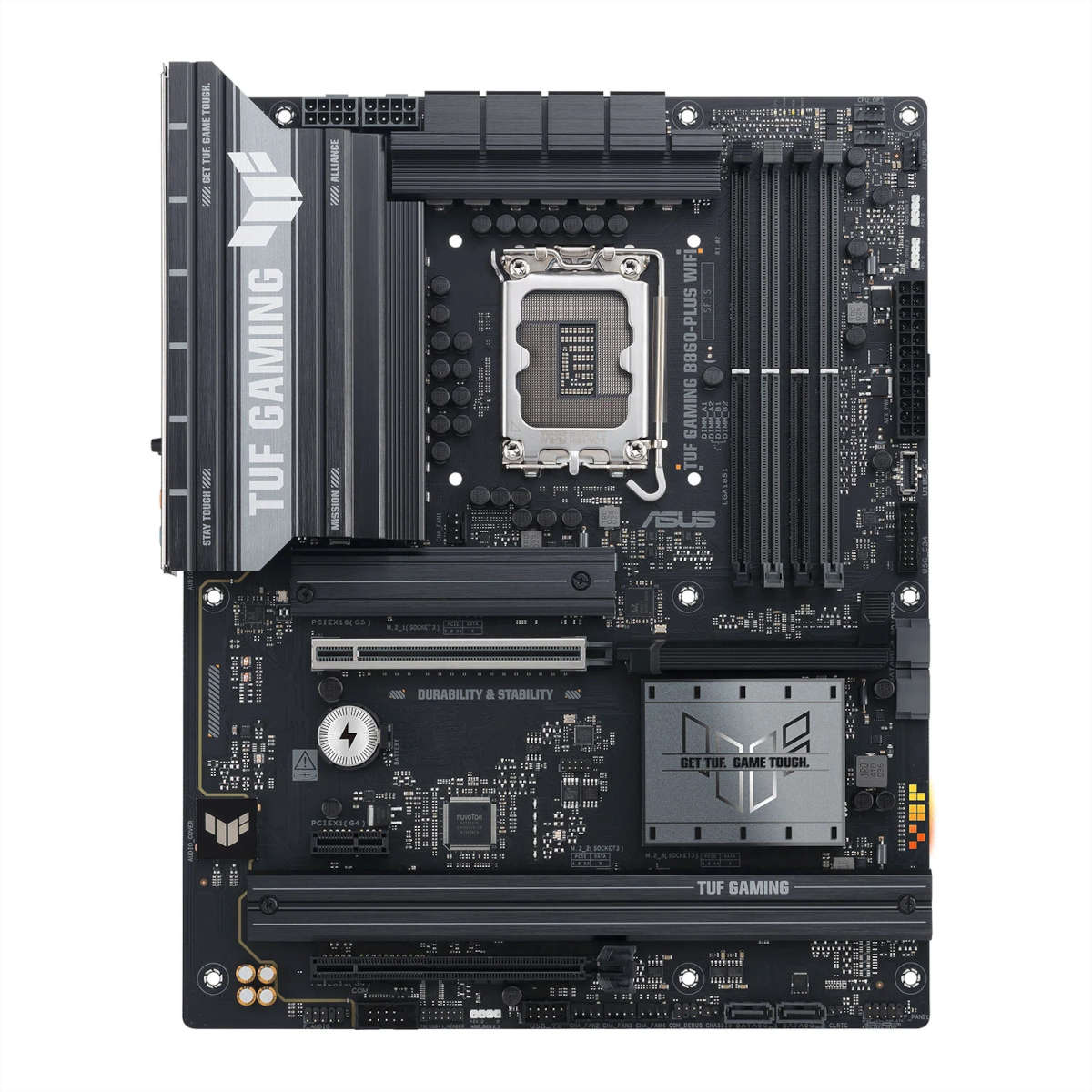
TUF Gaming B860-Plus WiFi
“TUF Gaming B860-Plus WiFi takes all the essential elements of the latest Intel Core Ultra processors and combines them with game-ready features and proven durability.” – Asus
There are three TUF Gaming B860 motherboards to choose from, made up of two ATX boards (B860-Plus WiFi and B860-Plus) and an mATX model (B860M-Plus WiFi). TUF Gaming B860-Plus WiFi offers the most complete feature set of the lot.
With a trio of TUF motherboards to choose from, Asus offers an mATX B860M-Plus WiFi and two ATX boards comprising B860-Plus WiFi and B860-Plus WiFi, the latter of which carries the most complete feature set.
| TUF Gaming B860-Plus WiFi | |
|---|---|
| VRM | 12+1+2+1, 80A |
| RAM support | Slots: 4 Capacity: 256GB Speed: 8,666+MT/s |
| Onboard graphics | DisplayPort 1.4 (x1) HDMI 2.1 (x1) USB Type-C (x1) |
| PCIe expansion slots | PCIe 5.0 x16 (x1) PCIe 4.0 x16 (x1) PCIe 4.0 x1 (x1) |
| Audio | Realtek HD Audio |
| Storage | PCIe 5.0 x4 (x1) PCIe 4.0 x4 (x2) SATA 6Gb/s (x4) |
| Rear USB | 20Gb/s Type-C (x1) 10Gb/s Type-A (x2) 5Gb/s Type-A (x3) |
| Front USB | 10Gb/s Type-C (x1) 5Gb/s Type-A (x2) 480Mb/s Type-A (x2) |
| LAN | Realtek 2.5Gb/s |
| Wireless | Bluetooth 5.4 WiFi 7 |
TUF Gaming B860-Plus WiFi drops Thunderbolt 4 but retains the DP Alt Mode of its more-expensive siblings via its single 20Gb/s USB Type-C port. Flanking that are two 10Gb/s headers and three 5Gb/s inputs, giving it plenty of connectivity and strong overall bandwidth.
You can fill up to three storage slots, one being the faster PCIe 5.0 x4 and two steering the course with PCIe 4.0 x4. The motherboard provides welcome room for expansion too via its PCIe 5.0 x16 port and its additional PCIe 4.0 x16 (supporting up to x4 speeds).
Asus has trimmed back the likes of TUF Gaming B860-Plus WiFi’s VRM, RAM speeds, and audio codec to further drive down the motherboard’s price but each are still of a suitably high quality. To the manufacturer’s credit, it retains Bluetooth 5.4 and WiFi 7 support alongside 2.5Gb/s networking albeit via Realtek rather than Intel.
Prime
Sporting the most affordable price tags Asus has to offer, Prime motherboards are designed with budget builders in mind. While they provide a basic feature set, they also mark an inexpensive way to create a system centred around a Core Ultra 200S processor.
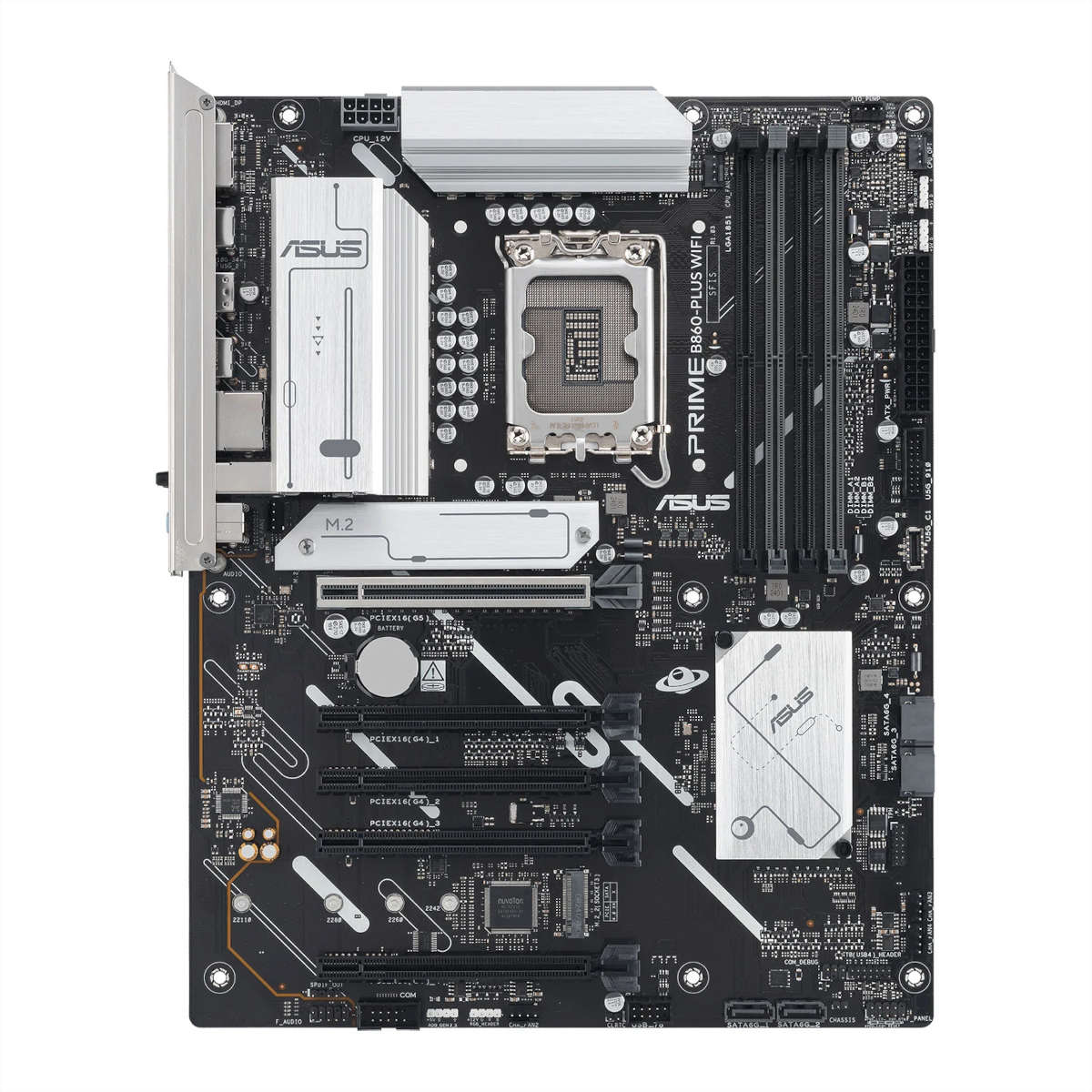
Prime B860-Plus WiFi
“Prime series motherboards are expertly engineered to unleash the full potential of the latest Intel Core Ultra processors.” – Asus
Asus offers five Prime motherboards in total, from three mATX models (B860M-A, B860M-A WiFi, and B860M-K) to two ATX models (B860-Plus and B860-Plus WiFi). As you might expect, the latter leads the pack.
| Prime B860-Plus WiFi | |
|---|---|
| VRM | 8+1+1+1, 80A |
| RAM support | Slots: 4 Capacity: 256GB Speed: 8,666+MT/s |
| Onboard graphics | DisplayPort 1.4 (x1) HDMI 2.1 (x1) |
| PCIe expansion slots | PCIe 5.0 x16 (x1) PCIe 4.0 x16 (x4) |
| Audio | Realtek HD Audio |
| Storage | PCIe 5.0 x4 (x1) PCIe 4.0 x4 (x1) SATA 6Gb/s (x4) |
| Rear USB | 20Gb/s Type-C (x1) 10Gb/s Type-A (x2) 5Gb/s Type-A (x1) 480MB/s Type-A (x4) |
| Front USB | 5Gb/s Type-C (x1) 5Gb/s Type-A (x2) 480Mb/s Type-A |
| LAN | Realtek 2.5Gb/s |
| Wireless | Bluetooth 5.3 Wi-Fi 6E |
Comparing Prime B860-Plus WiFi to its apex TUF Gaming sibling, there’s a surprising amount of similarities between them in terms of connectivity. The more-affordable motherboard matches its counterpart’s single 20Gb/s Type-C and two 10Gb/s Type-A USBs, in addition to its single PCIe 5.0 x16 and PCIe 5.0 x4 slots for graphics and storage, respectively.
Of course, bandwidth does shrink overall to keep costs down. Prime B860-Plus WiFi boasts fewer 5Gb/s USB ports, down from three to one, but does at least offer four 480Mb/s connections instead. Meanwhile, the motherboard doesn’t forgo additional storage or expansion, with an additional PCIe 4.0 x4 slot and four PCIe 4.0 x16 connectors (one capable of running at x4, while the rest run at x1).
To achieve this low a price point, dropping to Bluetooth 5.3 and WiFi 6E is a sensible choice. Besides, most buyers in this bracket are more likely to have devices using these standards than the latest ones. Asus doesn’t trim back wired network connectivity, though, sticking with a 2.5Gb/s port.
WiFi 7 routers
While most B850 and B860 motherboards support WiFi 7 out of the box, you’ll at the very least need a compatible router to take full advantage of the wireless standard. Speaking from my own experience with WiFi 7, making the switch can unlock the full potential of your broadband without the need for Ethernet, while also alleviating congestion and boosting the overall signal strength of your network.
As you might imagine, Asus has several WiFi 7 routers that pair well with its motherboards, complete with matching stylings for ROG and TUF Gaming models. Of course, there are stealthier alternatives available too. Here are a few choice cuts:
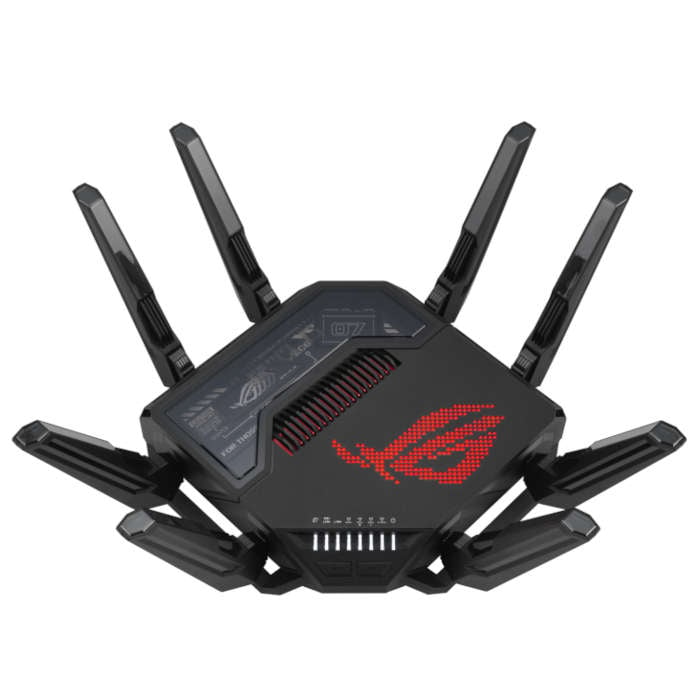
ROG Rapture GT-BE98
“ROG Rapture GT-BE98 is a quad-band WiFi 7 gaming router tailored for next-gen computing, with speeds of up to 25Gb/s and dual 10Gb/s ports.” – Asus
For those who must have the fastest networking possible, look no further than ROG Rapture GT-BE98. Delivering up to 25Gb/s of bandwidth across its quad frequencies, including 6GHz, this is about as fast as wireless networking gets in the consumer space.
It also features dual 10Gb Ethernet ports, with one serving as a dedicated gaming port, so you can rest assured a wired connection for your ranked matches is in safe hands. Of course, this is just scratching the surface of its many features, so check out its product page to learn more about this beast of a router.
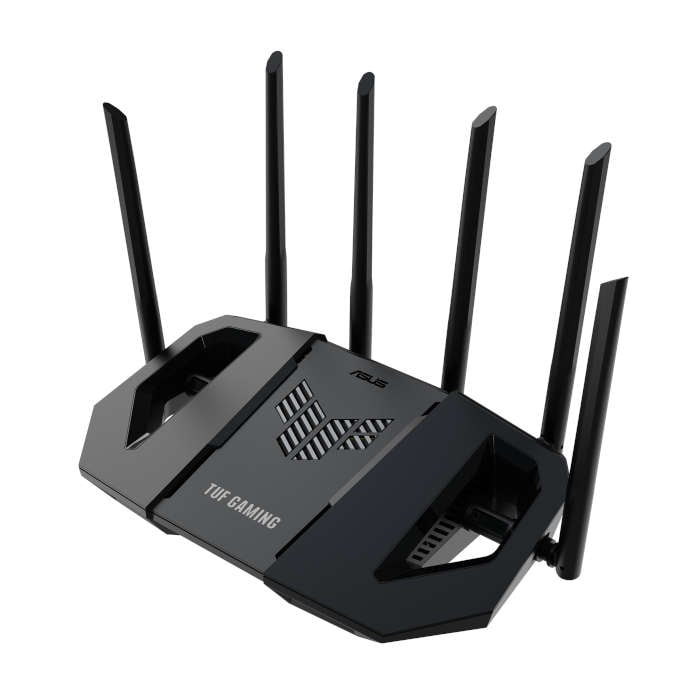
TUF Gaming BE6500
“Inspired by the unique design and power wings of drones, TUF Gaming BE6500 combines a sleek appearance with advanced cooling efficiency.” – Asus
Decidedly more affordable than its ROG counterpart, TUF Gaming BE6500 still has plenty to offer those in search of a router with gaming-specific features. Capable of communicating up to 6,500Mb/s of data across its 5.0GHz and 2.4GHz bands, there’s plenty of bandwidth here for most users.
While it trades away 10Gb Ethernet speeds, it still has several 2.5Gb headers to connect your PC and other devices to including that coveted dedicated gaming port. Visit the product page to learn about it.
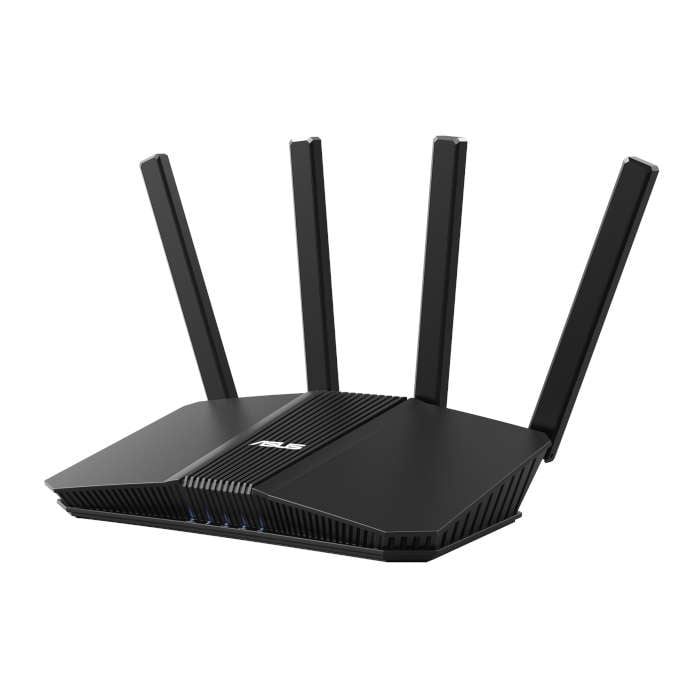
RT-BE58U
“With next-gen Asus Network Security and a suite of advanced technologies such as IoT Network, RT-BE58U safeguard your network end-to-end, 24/7.” – Asus
If you’re simply after a solid WiFi 7 router to replace the standard box your ISP supplies then RT-BE58U is worth a look. It supports both 2.4GHz and 5.GHz bands, through which it’ll handle up to 3,600Mb/s of traffic. Equipped with Simultaneous and Alternating MLO (Multi-Link Operation), any devices connected to it will always have the most stable and speedy line open to it.
Gigabit is the predominant name of the game here, but this unassuming black box still supports a single 2.5Gb port too among other enticing features. As ever, you’ll find anything and everything you need to know about it via its product page.
For more on all things motherboards and more, make sure to follow Club386 on Google News. There’s still plenty of exciting tech to talk about this year, so stay tuned.

